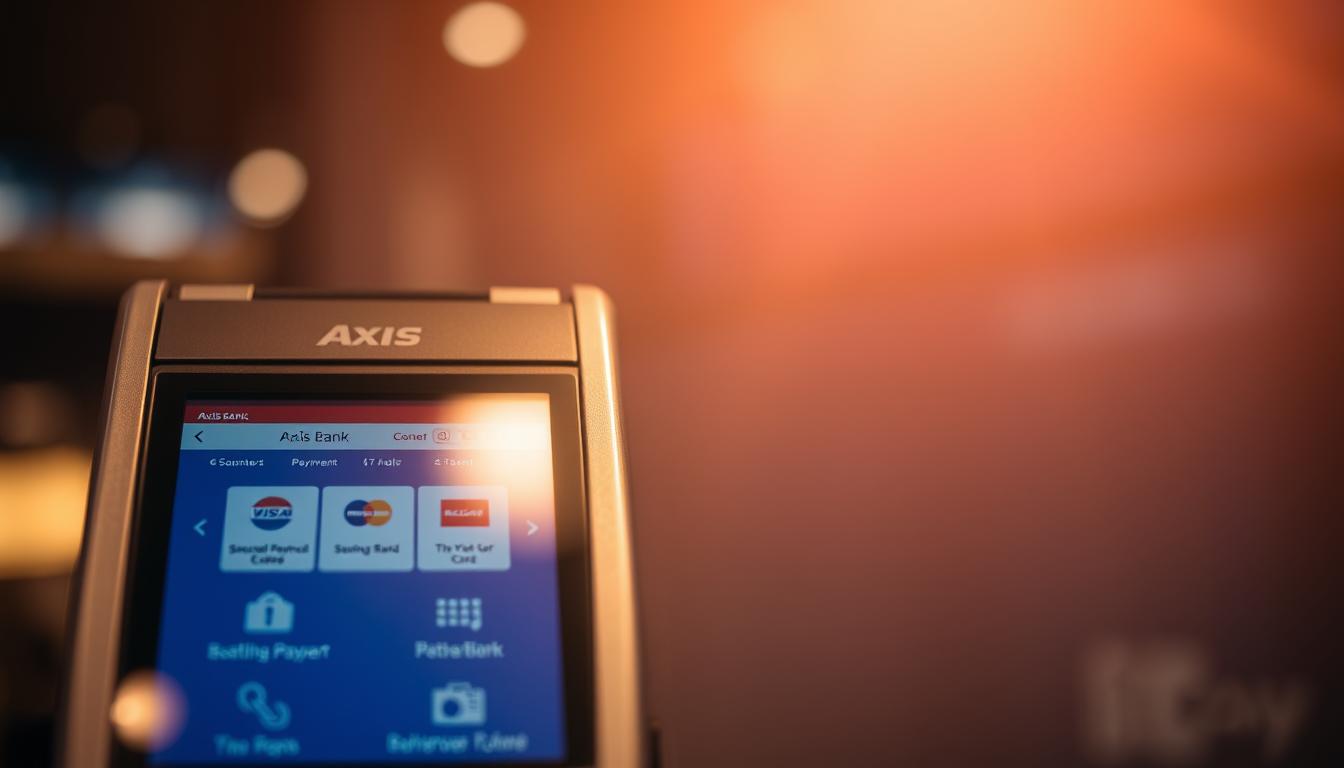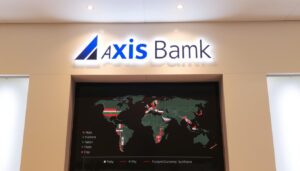Did you know that hidden fees can add up to 1-3% of every global transaction? For Indian businesses expanding overseas, these costs can significantly impact operational budgets. As international trade grows, understanding the financial details behind these transactions becomes crucial.
Axis Bank plays a key role in facilitating global trade. Their transparent fee structures help businesses navigate the complexities of cross-border payments. However, it’s essential to dig deeper into factors like currency conversion rates and wire transfer costs to avoid unexpected expenses.
By optimizing payment strategies, businesses can reduce unnecessary costs. Multi-currency solutions and careful planning are just a few ways to ensure smoother, more cost-effective transactions. Let’s explore how to make the most of your global payments.
Key Takeaways
- Hidden fees can add 1-3% to every global transaction.
- Axis Bank offers transparent fee structures for international payments.
- Understanding currency conversion rates is crucial for cost optimization.
- Wire transfer costs can impact overall transaction expenses.
- Multi-currency solutions help reduce unnecessary fees.
Introduction to Axis Bank International Payment Processing
Efficient cross-border transactions are essential for businesses. A reliable bank ensures seamless global payments, enabling companies to focus on growth. With a robust infrastructure, Axis Bank simplifies the complexities of international trade.
One of the key services offered is SWIFT transfers. This system ensures fast and secure fund transfers across borders. Additionally, currency conversion is handled efficiently, minimizing delays and extra costs.
Security is a top priority for cross-border transactions. Advanced encryption and fraud detection systems protect every transfer. This ensures that businesses can operate with confidence, knowing their funds are safe.
Using Axis Bank credit cards abroad comes with added benefits. Customers earn accelerated reward points and cashback on international spending. These perks make global travel and business expenses more rewarding.
Before traveling, it’s crucial to notify the bank. This prevents transaction blocks and ensures uninterrupted access to funds. A simple step like this can save time and hassle during trips.
- SWIFT transfers for fast global payments.
- Efficient currency conversion services.
- Advanced security protocols for safe transactions.
- Reward points and discounts on international spending.
- Pre-travel notifications to avoid transaction blocks.
Understanding Axis Bank Charges for International Transactions
Global transactions often come with hidden costs that can catch businesses off guard. To manage these expenses effectively, it’s crucial to understand the breakdown of fees. This section explores the types of fees involved and how they are calculated.
Types of Fees Involved
Several components contribute to the overall cost of cross-border payments. These include service charges, GST, and correspondent bank fees. Service charges typically range from 0.5% to 3% of the transaction value, depending on the amount and type of transfer.
GST, at 18%, is applied to the service fee. Additionally, correspondent bank fees may apply in multi-leg transactions, where funds pass through intermediary banks. Understanding these fees helps businesses plan their budgets more accurately.
How Fees Are Calculated
Fees are calculated using a straightforward formula: (Transaction amount × conversion rate) + percentage fee. For example, a ₹1,00,000 transaction with a 2% fee results in ₹2,000 in charges.
Dynamic currency conversion rates can also impact the final cost. These rates fluctuate based on market conditions, making it essential to monitor them closely. For more details on currency conversion, refer to this comprehensive guide.
- Service charges: 0.5%-3% of the transaction value.
- GST: 18% on the service fee.
- Correspondent bank fees: Vary based on intermediary banks.
Why Axis Bank Charges These Fees
Transaction fees are a necessary part of cross-border payments, but why do they exist? These fees cover a range of operational costs and services that ensure smooth global transactions. Understanding these components can help businesses plan their finances more effectively.
One major factor is the cost of using the SWIFT network. This global system ensures secure and fast fund transfers but comes with its own set of fees. Additionally, compliance checks are essential to meet regulatory standards, adding to the overall cost.
Currency risk management is another critical aspect. To mitigate risks, banks apply markups during currency conversion. This ensures stability in fluctuating markets but adds to the transaction fees.
Regulatory requirements, such as FEMA and RBI guidelines, also play a role. Implementing these rules involves administrative efforts, which are reflected in the fees. Furthermore, investments in advanced fraud prevention systems ensure secure transactions, contributing to the cost structure.
When compared to industry standards, these fees are competitive and justified. They cover essential services that enable businesses to operate globally without disruptions. Here’s a quick breakdown of the key reasons:
- Operational costs: SWIFT network fees and compliance checks.
- Currency risk management through conversion markups.
- Regulatory requirements like FEMA/RBI guidelines.
- Investments in fraud prevention systems.
- Comparison with industry-standard cost structures.
By understanding these factors, businesses can better appreciate the value behind the fees and make informed decisions for their global transactions.
Comparing Axis Bank Charges with Other Banks
When it comes to global transactions, understanding fee structures is critical for cost efficiency. A side-by-side comparison with other major financial institutions reveals key differences that can impact your bottom line.
For instance, international wire fees typically range from ₹1,500 to ₹4,000, excluding currency conversion costs. However, these costs vary significantly across banks. SBI, HDFC, and ICICI each have their own fee structures, which can influence your decision.
Currency conversion markups are another factor to consider. While some banks offer competitive rates, others apply higher markups, increasing the overall cost of transactions. Hidden fees, such as correspondent bank charges, can also add up, making flat charges a more predictable option.
Prepayment charges are another area where differences emerge. While some institutions charge 4%, others, like Axis, offer a lower rate of 2%. Similarly, cheque book issuance charges are standardized at ₹2 per leaf across the industry, ensuring parity in this aspect.
- International wire fees: ₹1,500-4,000 + currency costs.
- Currency conversion markups vary across banks.
- Hidden costs: correspondent bank fees vs. flat charges.
- Prepayment charges: 2% at Axis vs. 4% at competitors.
- Cheque book issuance charges: ₹2/leaf industry standard.
By analyzing these factors, businesses can make informed decisions and choose the financial partner that best meets their needs. A detailed comparison ensures cost efficiency and smoother global transactions.
How to Minimize Axis Bank International Payment Charges
Managing global transactions efficiently can save businesses significant costs. By adopting the right strategies, companies can reduce fees and optimize their finances. This section explores practical methods to minimize expenses while maintaining security and compliance.
Opting for Multi-Currency Accounts
Multi-currency accounts are a game-changer for businesses operating globally. These accounts allow companies to hold and manage funds in multiple currencies, reducing the need for frequent conversions. This can significantly lower the rate of transaction fees.
For example, integrating with platforms like PayPal or Wise can streamline payments. These platforms often offer lower FX margins, ranging from 0.5% to 1.5%, compared to traditional banking methods. This integration ensures smoother transactions and cost savings.
Using Digital Wallets and Alternative Solutions
Digital wallets and fintech solutions provide an efficient way to handle cross-border payments. Platforms like Karbon FX offer competitive rates and tailored services for recurring payments. A case study revealed a 23% savings for a business using Karbon FX for euro transactions.
Prepaid travel cards are another alternative, often costing less than credit cards for international use. However, it’s essential to consider compliance requirements when using these platforms. Ensuring adherence to regulations guarantees smooth and secure transactions.
- Multi-currency accounts reduce conversion fees.
- Integration with PayPal/Wise lowers FX margins.
- Prepaid travel cards offer cost-effective solutions.
- Karbon FX saves 23% on recurring euro payments.
- Compliance ensures secure and legal transactions.
Axis Bank’s Currency Conversion Rates Explained
Currency conversion is a critical aspect of global transactions, often influencing the final cost. Businesses must understand how these rates are calculated to avoid unnecessary expenses. The process involves two key rates: the mid-market rate and the bank-offered rate.
The mid-market rate is the real-time exchange rate used in global markets. However, banks typically add a margin to this rate, resulting in the bank-offered rate. This margin covers operational costs and ensures profitability. For example, if the mid-market rate for USD-INR is 75, the bank might offer a rate of 76.5.
Exchange rates are updated frequently, often hourly or daily, based on market conditions. This ensures that businesses get the most accurate rates for their transactions. However, fluctuations can impact the final cost, making it essential to monitor rates closely.
The RBI’s forex guidelines also play a role in determining conversion margins. These regulations ensure transparency and fairness in currency transactions. For instance, the Liberalized Remittance Scheme (LRS) caps USD receipts at $250,000 annually, influencing conversion strategies.
Historical data shows that the USD-INR rate has varied significantly over the past year. Analyzing these trends can help businesses plan their transactions better. Transparency measures, such as clear rate disclosure, further enhance trust and reliability in the process.
For businesses looking to minimize costs, understanding these factors is crucial. Platforms like Karbon FX offer mid-market rates, providing a cost-effective alternative to traditional methods. By leveraging such solutions, businesses can optimize their global transactions.
Common Pitfalls to Avoid with International Payments
Navigating global transactions requires awareness of potential pitfalls to avoid unnecessary costs. One common mistake is incomplete documentation, which can lead to penalties ranging from ₹500 to ₹2,000. Ensuring all paperwork is accurate and submitted on time is crucial.
Another issue is auto-conversion at POS terminals. This can result in unfavorable exchange rates, increasing the overall cost of the transaction. Always check the currency settings before making a payment abroad.
Understanding transaction limits is also essential. For instance, the Liberalized Remittance Scheme (LRS) caps USD receipts at ₹7 lakh annually. Exceeding this limit can lead to complications and additional charges.
Double conversion errors in third-party platforms are another risk. These occur when funds are converted twice, leading to higher fees. Always verify the conversion process to avoid such errors.
Late payments can also be costly, with penalties of 8% p.a. plus GST on overdue amounts. Staying on top of payment deadlines ensures smooth and cost-effective transactions.
- Incomplete documentation: ₹500-2,000 penalties.
- Auto-conversion risks at POS terminals.
- Transaction limits: ₹7 lakh LRS cap.
- Double conversion errors in third-party platforms.
- Late payment penalties: 8% p.a. + GST.
How to Check Your Axis Bank International Transaction Charges
Understanding your financial statements is key to managing global expenses effectively. Your account statements provide a detailed breakdown of every transaction, including the original amount, conversion rate, and applicable fees. This transparency helps you stay informed and avoid surprises.
Decoding your bank statement is straightforward. Look for the INR equivalent of the transaction, the conversion rate applied, and any additional fees. Mobile banking and net banking platforms offer convenient ways to verify these details. Both methods are user-friendly and provide real-time updates.
Tax breakdowns are another critical aspect. GST is applied to banking services, and understanding this component ensures accurate financial planning. If you notice any discrepancies, the dispute resolution process is simple. Contact customer support with your statement details for prompt assistance.
Monthly reconciliation is a best practice for maintaining financial health. Regularly reviewing your statements helps identify errors early and ensures all charges are accurate. This proactive approach saves time and prevents potential financial losses.
- Decode statements to understand fees and conversion rates.
- Use mobile or net banking for charge verification.
- Understand GST breakdowns on banking services.
- Follow the dispute resolution process for errors.
- Reconcile statements monthly for accuracy.
Conclusion
Optimizing global financial strategies ensures businesses stay competitive and cost-efficient. Understanding key charges and adopting smart solutions can significantly reduce unnecessary expenses. Regular audits and reviews of your bank partner’s fee structure are essential for maintaining cost efficiency.
Comparing traditional transactions with hybrid solutions reveals opportunities for savings. Multi-currency accounts and digital wallets often offer lower fees and better rates. Staying updated on future trends in cross-border payments can further enhance cost optimization.
For personalized insights, consult with financial experts to analyze your specific needs. This proactive approach ensures smoother, more cost-effective global operations.







